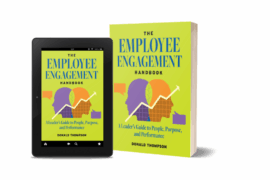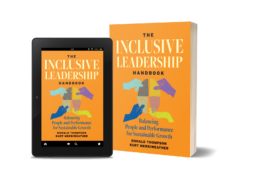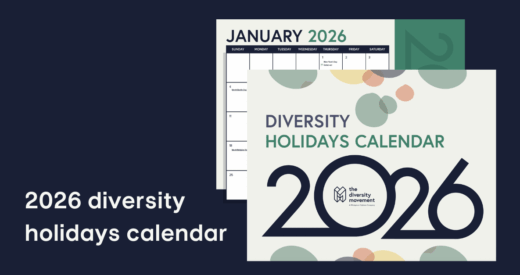Like the internet did 30 years ago, artificial intelligence (AI) is transforming the workplace and society. This latest technological breakthrough is already enhancing productivity, streamlining business operations, and enabling better decision-making. At the same time, the rapid pace of change is causing anxiety, with many people afraid that they will lose their jobs.
According to a 2025 report from McKinsey, 78% of organizations are already using AI for at least one business function, and over 90% plan to increase their investment over the next three years. To help their teams harness the full benefits of AI, inclusive leaders can drive success by adopting strategies that promote trust and well-being, along with technical proficiency. By prioritizing clear communication, targeted training, and psychological safety, organizations can ease concerns and ensure AI sparks innovation, not fear.
Facing the Fears: The Causes of AI Anxiety at Work
It’s natural for people to feel uncertain or anxious when roles are evolving, new skills are required, and the future feels unpredictable. Complex feelings about AI—both fear and excitement—are a reasonable response to disruption. However, negative emotions can slow AI adoption, so they should be addressed directly and compassionately. Leaders who understand the psychological landscape can better support their teams through the transition.

Fear No. 1: “AI will take my job.”
The World Economic Forum’s Future of Jobs Report 2025 estimated that 92 million jobs may be lost due to automation. While that statistic is sobering, the same report projected that AI would create approximately 170 million new jobs globally. This means there will be a net increase of 78 million jobs overall. Roles will evolve—but human oversight, critical thinking, and creativity can’t be automated.
Fear No. 2: “I won’t be able to learn it.”
The rapid development of AI tools and a lack of effective training have left many employees feeling overwhelmed. According to a recent Corndel study of U.K. companies, only 14% of employees received highly effective AI training. The same report found that 74% of younger staff used AI tools regularly, but only half had received formal instruction. To ensure employees have the support and knowledge they need, accessible learning opportunities must be built into any AI rollout.
Fear No. 3: “AI isn’t fair or trustworthy.”
Several studies have found that large language models demonstrate bias across race, gender, and socioeconomic status. Hallucinations—when AI generates false or misleading responses—are also a risk. These issues reinforce the need for ethical guardrails and transparency in how AI is used, particularly in hiring, performance reviews, and other processes that involve people. In addition, professionals with a solid grounding in inclusive language and a thorough understanding of unconscious bias should be writing the prompts and reviewing the outputs.
Emphasize the Benefits to Employees
To alleviate AI fears and pave the way for learning and growth, it’s up to leaders to clearly communicate that AI is an enhancement rather than a threat.
“Messaging around AI has to be that we care about you, that we see you, that we hear you, and that we want to know how to support you. When you do that, you create an environment that reduces anxiety,” says Valerie Merriweather, Founder and Chief Wellbeing Officer of Fitwell Solutions.
AI has the potential to make work more meaningful, and it should be framed as a tool that “helps employees feel like they’re not just a cog in the wheel,” she explains. According to some estimates, workers spend 40–50% of their time on mundane tasks like data entry and research. If these tasks can be automated, employees will have more time for creativity, connection, and problem-solving. Whether helping someone learn a new skill, organize their day, or make smarter decisions, AI can act as a support system—not a threat—when deployed with intention.
Leading Through Change with Empathy and Clarity
The key to effective AI adoption is human-centered leadership. Employees don’t just need instructions; they need reassurance and a roadmap. Greg Boone, CEO of North Carolina marketing agency Walk West, encourages leaders to meet people where they are, tailor learning experiences, and emphasize that AI is about career advancement—not replacement.
“AI adoption starts with training every single employee, not just the folks that are going to be critical to IT or the business part of your organization,” says Boone, a seasoned leader in AI-driven marketing and digital transformation. “Think about job evolution, not job elimination. Help folks figure out how they can use these tools and be more productive in their individual roles.”
Training should go beyond technical demonstrations. It should include real-life use cases, safe spaces to practice, and clear boundaries around acceptable use. That means making space for trial and error, as well as consistent feedback.
“It’s helpful to get the people in your organization who are excited about this, to give a little bit of space to play and to try different things out. You’re going to get a lot wrong and then you’re going to get some stuff right,” says Darrell Fruth, a partner at Smith Anderson and head of the North Carolina law firm’s task force on the ethical and effective use of AI.
That mindset—embracing mistakes and learning in public—builds psychological safety and models the kind of adaptive behavior AI requires.

Practical Steps for Managers and People Leaders
To move from AI anxiety to engagement, HR professionals and managers can guide their teams through this cultural shift with these strategies:
- Communicate with transparency. Share how AI is being used, what guardrails are in place, and how decisions are made. Reassure employees that they’ll be supported as workflows and job responsibilities change.
- Invest in inclusive training. Offer hands-on learning that meets a variety of experience levels and learning styles. Create hubs for collaboration, experimentation, and shared discovery. Pilot low-risk, high-value processes like preparing for meetings or drafting emails.
- Embed psychological safety. Employees need permission to explore, learn, and fail without fear. Inclusive leaders model curiosity, admit when they don’t have the answers, and experiment openly to create space for others to do the same.
- Make it personal. Use real-life examples and low-stakes projects to show how AI can help employees succeed in their roles. Showcasing a tool that saves time or sparks creativity makes the technology less abstract and more practical.
- Address bias and equity concerns. Align AI guidelines with organizational values by working closely with Diversity Councils to evaluate AI tools for fairness and representation. Set clear criteria for inclusive language and regularly audit AI outputs to mitigate potential bias.
A More Human Future, Powered by AI
AI has the potential to enhance employee engagement—if leaders keep people at the center. Used wisely, it can improve workflows, reduce stress, support career growth, and redefine meaningful work.
But successful adoption depends on more than just using the latest AI tools. It requires thoughtful leadership, inclusive communication, and a deep commitment to trust. As AI becomes embedded in daily work, organizations must invest in the people using it—not just the platforms powering it.
Leaders who embrace this mindset will future-proof their organizations by building cultures where employees feel valued, empowered, and ready to grow.
For more ideas on how to mindfully integrate AI in the workplace, listen on-demand to The People Impact of AI: Does AI Help or Harm Employee Engagement? Our panel of experts explores strategies to maximize AI’s benefits, while safeguarding engagement, well-being, and workplace relationships in an era of rapid transformation.
Amber Keister is a Content Strategist at The Diversity Movement. She has spent more than 20 years as a journalist for publications throughout the South. Connect with her on Linkedin.




